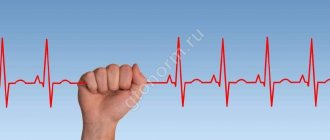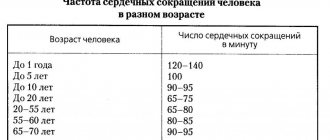The importance of heart rate during training
Monitoring heart rate during training is necessary to:
- determine the intensity of classes;
- effectively use oxygen to generate energy during aerobic exercise;
- choose a load to develop endurance;
- prevent stress on the cardiovascular system.
Those who have problems with the heart and blood vessels should be especially careful during exercise. For such patients, the load is selected based on an ECG machine with tests on a bicycle ergometer.
A sudden achievement of maximum heart rate is also contraindicated for those who have not previously exercised at all. Like other muscles in the human body, the heart needs time to reach a certain exercise regime. The duration of the preparatory period should be from three to six months.
With the correct load, heart rate should be measured several times:
- before classes;
- after warming up;
- at the end of the main part;
- when the load decreases;
- after classes during the cool down process.
IMPORTANT! Pulse is considered a more objective criterion of literacy in classes, in contrast to well-being.
How to strengthen your heart through exercise?
Thirdly, the workout should be long, approximately 20 to 60 minutes. Fourthly, in order not to harm your health and achieve a training effect, you need to ensure that during cardio training your heart rate is within certain values. Target heart rate values are individual and depend on age and the initial state of the cardiovascular system.
If you have been examined by a cardiologist and know for sure that you do not have diseases of the cardiovascular system, then you can independently calculate the target training intensity. This is done by assessing your heart rate during physical activity. The optimal heart rate for training the heart muscle is to achieve the so-called submaximal heart rate, which corresponds to 75% of the maximum heart rate for your age. To calculate the optimal heart rate during training, use the formula: (220 - age) x 0.75. For example, if you are 37 years old, then your maximum heart rate is 183, and your submaximal heart rate is 137. That is, to achieve the effect during training, you need to maintain a heart rate of 137 beats per minute.
If you have not had a cardiovascular examination for a long time and are planning to engage in cardio training, it is better to undergo a “technical examination” and go to a cardiologist. Modern diagnostic methods allow you to accurately and quickly assess your cardiovascular system. It is better to discuss with your doctor not only the intensity and type of future training, but also your diet. The EMS clinic has a rapid diagnostic program “Healthy Vessels and Heart”. The program includes a minimal but sufficient list of examinations and helps the patient avoid unnecessary costs and time. On the first visit to the clinic, the patient undergoes laboratory tests and undergoes a triplex scan of the neck vessels (ultrasound) and then comes to the cardiologist with the results in hand. At the appointment, the doctor collects anamnesis, listens to complaints, studies research results, takes an ECG and at the end of the appointment makes recommendations. Otherwise, if you first just go to the cardiologist, he will prescribe tests at the first appointment, and then an additional appointment will be required to evaluate their results. This program is also recommended if you have risk factors, such as smoking, increased weight or stress, or close relatives with cardiovascular diseases. If indicated, the cardiologist may refer you for additional examinations depending on the initial condition of the heart and the planned load.
During properly conducted cardio training, not only human muscles are trained, but also the cardiovascular and respiratory systems: the contractility of the heart improves, the number and size of blood vessels feeding the heart increases, the vital capacity of the lungs and tidal volume increase. All this leads to an improvement in the functional state of the cardiovascular and respiratory systems, to the enrichment of the body with oxygen, a gradual decrease in heart rate at rest, and an increase in resistance to physical activity. And all this as a whole allows you to better understand the secret of not only a beautiful, but also a healthy body.
Pulse zone
Pulse is the rate at which the heart beats over one minute. There is also the concept of a pulse zone, which determines the range from the heart rate at rest to the maximum load on the body.
In everyday life, a person does not need to monitor his pulse zone. But for athletes this parameter is very important. The fact is that when the heart rate is in only one zone, it promotes weight loss; at high values, the endurance of the human body increases
Help: Each person has his own pulse zone, which is determined using laboratory tests.
What is the problem?
So there is a heart rate at which the highest percentage of calories burned is from fat. This gave rise to the idea of the need to exercise only in the “fat burning zone”.
But just because more fat is used as a percentage, does not mean that a lot of fat is wasted in absolute terms.
Example
- You walk slowly at a speed of 3 km/h and burn 5 kcal/min. You burned 300 calories, almost all of them from fat.
- You run at a speed of 9 km/h and burn 15 kcal/min. You burned 900 calories, but only half of it was fat. In percentage terms, you burned less fat, but in absolute terms - 450 calories, and that's more. Obviously, we burn more calories when we exercise intensely.
Lyle MacDonald writes:
High-intensity cardio may be more effective for weight loss. Under these conditions, you deplete your glycogen stores since carbohydrates are your primary source of fuel. But after training at rest, the body will burn more fat, and the carbohydrates supplied with food will go into glycogen. But in the grand scheme of things, everything you burn during a workout is less important than what you burn throughout the day (i.e., you're in a calorie deficit).
Safe heart rate during exercise
Heart rate is an objective criterion for assessing training load during training. Using heart rate, you can regulate the intensity of your exercise.
During aerobic exercise, heart rate indicators are not informative and cannot be used to regulate strength loads in the gym.
During sports exercises
Physical activity makes the heart beat faster. As a result, the volume of pumped blood is often released into the system to supply the human muscles and organs with oxygen, so the number of shocks increases greatly.
If the body has not previously been exposed to heavy exercise, then a high heart rate during sports is considered normal. For professionals, even during training, the heart rate increases slightly, which is explained by constant cardio loads. The heart muscle gets used to it over time and copes with pumping blood without effort.
Heart rate during strength training
Strength loads are characterized by higher heart rate readings, unlike walking or running. After them, the pulse rises to ninety percent of the maximum, but this value is suitable for healthy people. When there is no preparation or a person has suffered from any illness, the heart rate cannot be increased above 85%. For example, if a person is forty-five years old, then the permissible limit is 85% of the maximum: 220 − 45 = 175, which is 149 beats per minute.
The main thing here is to wait for the pulse to recover before another approach. He should get back to ninety beats per minute. A person should not experience shortness of breath, increased heart rate or discomfort in the heart area. If the pulse has not decreased in seven minutes, then this indicates an incorrectly selected load, and it must be reduced.
Help: If you do strength exercises with a constantly high heart rate, this can disrupt the nutrition of the myocardium.
During cardio training
This category includes fitness training. In other words, your heart rate should be between 135 and 150 beats per minute. But first you need to undergo a special computer examination, which will help determine the upper and lower pulse threshold.
Help: The duration of cardio training should be from forty to fifty minutes.
Heart rate while walking
Walking is extremely beneficial for the human body. They improve well-being, lift your spirits and promote weight loss. The normal heart rate when walking is from 100 to 125 beats per minute. At rest, normal rates are from sixty to one hundred beats per minute.
Heart rate when running in women and men
Normally, the pulse of women and men is different, but besides this indicator, there are others that radically change the final value.
The normal heart rate for men can be determined using averaged data. There are several types of loads, and they all differ in maximum heart rate and training efficiency.
For a man with average physical shape:
- warm-up - from 95 to 115 beats per minute;
- walking - from 115 to 135;
- jogging - from 134 to 154.
Help: Anything higher than the presented indicators is considered excessive and has a negative effect on the human body.
Women's indicators are as follows:
- warm-up - from 97 to 117 beats/min;
- walking - from 117 to 136;
- jogging - from 136 to 155.
While cycling
With such loads, the heart rate becomes seventy percent higher than the maximum. This frequency is used to restore the body after high loads; it can be alternated with an active mode within 70–80 percent.
If classes are held within 75% of the maximum, then endurance increases and fat burning occurs. You can move into the zone with a heart rate of eighty or ninety percent of the maximum and above for no more than one minute.
Heart rate during interval training
These are aerobic exercises that differ from standard ones in that they involve alternating pace and level of stress on the body. This type of training is used by bodybuilders, as interval training helps burn fat without losing muscle mass and increases the volume of the heart, which helps bodybuilders cope with pumping a large volume of blood.
The heart rate during such training ranges from 90 to 100 percent of maximum. Of course, there are programs that assume smaller values. Here everyone chooses the program that suits them best.
Heart rate norms for sports
August 17, 2016
Pulse is important not only for the average person, but also for those who play sports. How does it affect the training process, and what heart rate standards are there (if any) for representatives of different sports?
Modern sports are not what they used to be. Moreover, development is moving towards positive changes, adapting to modern trends and genetic changes in people’s bodies. Compare, for example, boxing before and now. Everything has changed: technique, speed, and rules. Of course, the basic elements remained unchanged, but still a lot has changed. Every year the popularization of a healthy lifestyle among the population is growing and, consequently, the number of people involved in sports is increasing. Even if they do it at an amateur level. This is also due to the fact that now it is not necessary to have a medical education and work in a clinic, surrounded by various devices, in order to carefully monitor your health. Scientific and technological progress has taken a very big step forward over the past three decades. Now you can do a lot of simple, everyday research without leaving your home. Of course, doctors are increasingly placing various sensors on professional athletes during training, but this has transferred to amateur sports in a much simpler and more accessible form. For example, a watch has long ceased to be an accessory that simply shows the time. At the moment, they have become “wiser” and acquired many additional functions. The most popular is measuring changes in heart rate. Why would a person involved in sports even know this? How will this affect the training process, and what heart rate standards are there (if any) for representatives of different areas of sports culture? Now let's figure it all out. Pulse is an important part when assessing the effectiveness of training. By knowing your heart rate, you can approach your workouts more consciously, knowing where you can increase the load and when you need to slightly reduce the intensity of the workout. However, first you need to understand what affects the pulse?
- Physical state. The better trained you are, the fewer contractions your heart needs to make.
- Human weight. With greater body weight, the heart has to work harder.
- Smoking, along with alcohol, makes our heart work harder.
- Our psycho-emotional state. Emotions and the functioning of the body are closely related - for example, when we are angry, our heart beats faster.
- Temperature. The colder it is, the lower the contraction rate.
Under different loads, a person's heart rate will change differently. So, for example, for those who began to engage in a sport where endurance is required, the average resting heart rate will be about 50 beats per minute for people 22-25 years old. While for those who train in speed-strength sports, this value is equal to 57-61 beats per minute. For beginner athletes, this value is even slightly higher - approximately 65 strokes.
Why is it even necessary to know your pulse during sports? For example, to accurately understand that you are training to the best of your real capabilities and are not “freeloading”, justifying yourself with fatigue. Pulse is an excellent assistant in determining your own load in order to work out really effectively, without overworking yourself too much and without slacking off at the same time. To determine your heart rate during training, you must first find out your maximum threshold. For men it is calculated according to the formula: 220 minus age, and for women - 226 minus age. For example, for a 25-year-old guy, the maximum heart rate (heart rate) is 195 beats per minute.
A couple more useful numbers and formulas:
When warming up, the heart rate should not exceed 50-60%
from the maximum value.
Thus, based on the average indicators, you can start training with a heart rate from 97.5 to 117
(calculated using the formula 195 * 0.5 = 97.5).
During cardio training, heart rate should not exceed 60-70%
of the maximum.
When running, this value increases to 70-80%
.
By the way, during long workouts it is especially important to monitor your heart rate so that it does not go into the so-called “red zone,” which is 90-95%
of the maximum value.
You should start playing sports wisely, choosing suitable shoes and clothes, developing a training system and monitoring your condition.
Only with a responsible approach can a person achieve truly good results and maximize their physical fitness. Tags:
- Sport
- Pulse
To leave a comment you must be an authorized user
Maximum heart rate in older people
In older people, it is contraindicated to increase the maximum heart rate to ninety percent; seventy percent is enough. These recommendations are suitable for people who do not have heart problems.
But if a person has suffered a heart attack, has angina pectoris or arrhythmia, then it is necessary to select an individual pulse threshold. This can only be done using an ECG with stress. Its meaning is that the patient’s electrocardiogram is recorded at the time of exercise. The doctor uses it to find the maximum limit that the patient should not exceed.
Training rules
To prevent training from negatively affecting your heart condition, you should follow simple rules. “If you come to a fitness club for the first time, it is reasonable to contact a trainer to choose an adequate physical activity for yourself, taking into account your weight, age, and the presence of chronic diseases. You should also not overdo it in the club, especially in the first lesson. After all, you should understand that this is already stressful for you, and before there was no proper physical activity,” says Tatyana Shalygina.
It is worth strictly remembering the stages and frequency of training. “First of all, the key to the success of training is its regularity, which means 2-3 times a week. In addition, they must be at least an hour in total when you visit a fitness club. This is true even for walking outside, which we often recommend to patients with cardiovascular disorders. We recommend walking for at least an hour, preferably 2 hours. And we recommend taking 6-10 thousand steps a day,” says the cardiologist.
Fashion for health. Bright Soviet posters about sports Read more
In addition, Tatyana Shalygina notes, the stages of training are also important for proper heart function. The first stage is preparation for the load. It takes approximately 10-15 minutes from the workout if we take the workout for an hour. The main stage should be about 30 minutes, when the main load on the body occurs. And, of course, a recovery period is required, when a person gradually reduces the load, including restoring the heartbeat.
“If at any stage, especially in the first days of attending training, any complaints arise in the form of severe shortness of breath, increased palpitations that the patient feels, a feeling of interruptions in the heart’s function, you should slowly stop training and then seek advice from a cardiologist or a therapist,” says Tatyana Shalygina.
If your heart rate is low during exercise
A low heart rate during exercise, as noted above, indicates a disruption in the functioning of the cardiovascular system. Doctors say that people who do not reach one hundred beats per minute in six minutes are at risk of developing a complex form of arrhythmia in the future, so they need to be examined.
A slow pulse is affected by blood pressure lowering medications for tachycardia, lack of thyroid hormones, and stomach ulcers. Professional athletes tend to have low heart rates due to overtraining.
You need to know your pulse during training in order to exercise effectively without harming your heart. For the calculation, the maximum value and zone of permissible increase in aerobic loads are used. The correct training plan is one that slows your resting heart rate.
Pulse on the monitor
Modern treadmills or exercise bikes will not only count your heart rate, but also tell you whether everything is normal. Wonderful! It just happens that you feel great, but the device sounds the alarm. What's wrong?
What’s “not so” is that the tables that help you navigate within the normal range are usually based on a very simple formula: “220 - minus age.” The authors, doctors Haxel and Fox, did not even claim to be correct in this calculation.
The formula takes into account the number of years lived - but is not at all interested in how they were lived! In order to calculate the optimal indicators for a particular person, it is very important to pay attention to age, lifestyle and level of training.
Is the simulator aware of existing sports victories or records in lying on the couch? While a skilled athlete can allow himself to accelerate the “main engine” to more than 200 beats per minute, for his untrained peer, a beginner, a “speed” of 160 heart beats per minute can become fatal.











